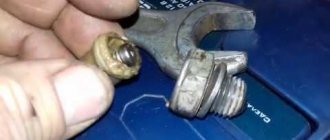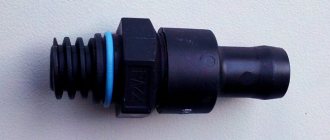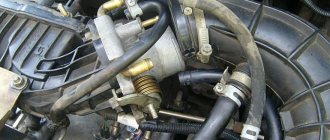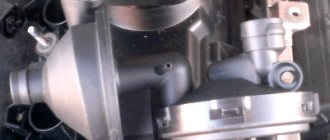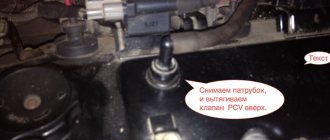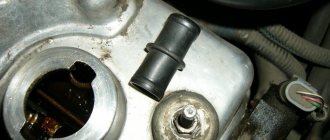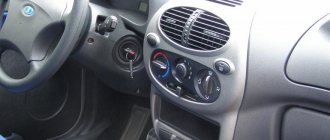Today we’ll talk about the ventilation system crankcase gases on Kalina with an 8-valve engine. And to be more precise, about cleaning this system. Crankcase gases straight from the crankcase (hence the name) are sent mixed with air to the intake manifold for re-burning, thus saving a certain percentage of fuel. So, along with the gases, oil particles enter the system and clog it.
It is this oil that needs to be cleaned from the crankcase ventilation system. Over time, plaque forms on the walls of the hoses, which impedes the passage of gases.
In the Kalinovsky engine, in the valve cover, there is a special separator that separates crankcase gases from the oil. It gets clogged the most. So, let's get started. The entire ventilation system consists of 3 pipes. We need to unscrew them.
Then remove the valve cover. There are two bolts on the back side, unscrew them and get to the separator.
The easiest way to clean it from oil and deposits is in a bath of gasoline or solvent.
While the separator is acidifying, you can work on the pipes. In general, if they are heavily soiled, it is advisable to replace them with new ones. In my case, I replaced only one - coming from the valve cover to the air filter pipe. The rest were washed with carburetor cleaning fluid (great stuff, it corrodes absolutely everything). The separator itself can also be washed a second time with this thing.
We wipe everything with a clean cloth and put it back together as it was. Pay attention to the condition of the valve cover gasket. It is considered disposable and it is better to replace it with a new one each time you remove it in order to avoid oil leaks.
Improved crankcase ventilation Kalina
Today we’ll talk about the crankcase on Kalina with an 8-valve engine.
And to be more precise, about cleaning this system. Crankcase gases straight from the crankcase (hence the name) are sent mixed with air to the intake manifold for re-burning, thus saving a certain percentage of fuel. So, along with the gases, oil particles enter the system and clog it. It is this oil that needs to be cleaned from the crankcase ventilation system. Over time, plaque forms on the walls of the hoses, which impedes the passage of gases.
In the Kalinovsky engine, in the valve cover, there is a special separator that separates crankcase gases from the oil. It gets clogged the most. So, let's get started. The entire ventilation system consists of 3 pipes. We need to unscrew them.
Then remove the valve cover. There are two bolts on the back side, unscrew them and get to the separator.
The easiest way to clean it from oil and deposits is in a bath of gasoline or solvent.
While the separator is acidifying, you can work on the pipes. In general, if they are heavily soiled, it is advisable to replace them with new ones. In my case, I replaced only one - coming from the valve cover to the air filter pipe. The rest were washed with carburetor cleaning fluid (great stuff, it corrodes absolutely everything). The separator itself can also be washed a second time with this thing.
We wipe everything with a clean cloth and put it back together as it was. Pay attention to the condition of the valve cover gasket. It is considered disposable and it is better to replace it with a new one each time you remove it in order to avoid oil leaks.
White smoke
If white smoke sometimes comes out of the exhaust pipe due to a cooled engine, then this may be quite normal, but if this phenomenon has become frequent, and it was not observed before, then it is worthwhile to diagnose the car and subsequently repair it.
Let's talk about the reasons why thick white smoke may form from the exhaust pipe and what malfunctions it may indicate.
So, first, let's define what the exhaust as a whole is essentially? The exhaust is a mixture of nitrogen, water vapor and carbon dioxide. In principle, if the engine and other car systems are working properly, then the exhaust should not have any color, because exhaust systems have a special component - a catalyst that cleans the exhaust from various gases and other substances. So why does the engine sometimes smoke white smoke? There may be two main reasons for this phenomenon:
- Technical problem
- The process of condensate evaporation.
White smoke due to condensation
As mentioned above, a situation often occurs when a driver approaches his car in the morning, starts the engine and notices that thick white smoke begins to come out of the exhaust pipe of his car. In case of high air humidity or during the cold season, condensation may form on the walls of the exhaust pipe circuit.
When the driver starts the engine, the muffler heats up, and the resulting moisture mixes with the exhaust gases, causing white smoke to come out of the exhaust pipe. This phenomenon can occur until all the condensate that has formed in the system comes out.
If the air temperature is less than 10 degrees, then white smoke will come out even when the engine heats up for a long time. At its core, it is not smoke, but just steam.
You can also pay attention to the presence of water drops on the exhaust pipe. Such vapor dissipates quite quickly in the air
Modification of the crankcase ventilation system Kalina 8 valves
This system could be improved a little. One of the 3 pipes supplies crankcase gases directly to the throttle valve assembly next to the IAC. If they contain oil, it will definitely settle there. This is how the IAC becomes clogged. So, to avoid this, you can embed a regular fuel filter right in the middle of this pipe.
It will trap oil particles contained in crankcase gases. After a few hundred kilometers, you will see for yourself. Monitor the condition of this filter and promptly change it to a new one. On average, as practice shows, it needs to be changed every 1000 kilometers.
First option
Modification of crankcase ventilation can be done in several ways. For example, on the M50 you can install an oil separator unit from the M52 model. However. This manipulation does not solve the problem of having a container for draining liquid, external aesthetics and the need to place a water seal.
One of the current solutions to the problem under consideration would be the installation of a HEPA filter, which contains wire and filament components that make it possible to adjust as accurately as possible the amount of gases released. The inside of the oil separator is filled with copper wire wool. In the standard version, the packing should protrude slightly beyond the base of the lid. The corrugated inlet and throttle assembly are thoroughly wiped. After performing the manipulations, the element is checked by mechanical purging for changes in air flow.
As practice shows
, operating a car with an improved crankcase ventilation system does not give you any reason to worry about excessive oil separation. The modification carried out according to the “NERA” principle, after a run of 15 thousand kilometers, shows that the appearance of oil stains in the system has disappeared, and the corrugation remains absolutely dry. The throttle block is also clean. Impurities settle on the wire packing, which, according to the laws of physics, move towards the oil separator cover. The filler periodically requires cleaning by performing a simple procedure of removing the cover and rinsing it with gasoline.
Video
Tools:
- Open-end wrench 10 mm
- Open-end wrench 13 mm
- Open-end wrench 17 mm
- Medium Phillips screwdriver
Parts and consumables:
- Gasoline/kerosene
- Rags
- Sealant
- Automotive compressor
- Cylinder head cover gasket (if replacement is needed) -2108-1003270-10
Read more: When to press the clutch
The crankcase ventilation system of the VAZ Lada Kalina 1118 tends to accumulate tarry deposits from crankcase gases, which make it difficult to remove these gases into the engine cylinders for combustion. Because of this, the gas pressure inside the engine increases and oil leaks through the seals appear. We recommend cleaning the crankcase ventilation system before each oil change.
1. Remove the decorative plastic engine cover.
2. Loosen the clamp and disconnect the hose of the large branch of the crankcase ventilation system from the air supply pipe.
3. Disconnect the second end of the large crankcase ventilation system hose from the fitting on the cylinder head cover and remove the hose.
4. Similarly, remove the hose of the small branch of the crankcase ventilation system by disconnecting it from the fittings of the throttle assembly and the cylinder head cover.
5. Remove the supply hose of the crankcase ventilation system by disconnecting it from the fittings of the cylinder block and the cylinder head cover.
6. Rinse the hoses with gasoline or kerosene, blow with compressed air and dry. Clean the holes in the fittings and pipes for connecting the hoses.
7. Unscrew the two fastening nuts and remove the cylinder head cover.
8. Unscrew the long 1 and short 2 bolts securing the oil separator from the inside of the cylinder head cover and remove the washers.
9. Remove the oil separator housing.
10. Remove the mesh pack from the cylinder head cover.
11. Thoroughly rinse the screens, oil separator housing and cylinder head cover with kerosene.
12. Turn the meshes in the bag so that they are oriented in the same way, and install the bag in the lid so that on one side it rests against the protrusions in the lid, and on the other side you can see the hole for the bolt that secures the oil separator of the VAZ Lada Kalina 1118.
13. Install the oil separator housing and tighten its mounting bolts.
14. Check the condition of the cylinder head cover gasket and replace if necessary.
15. The hoses of the crankcase ventilation system and the cylinder head cover of the VAZ Lada Kalina 1118 are installed in the reverse order of removal.
The article is missing:
- Photo of the instrument
- Photos of parts and consumables
- High-quality photos of repairs
If, while operating a LADA car, you notice that during load (when the air conditioner is running, the heating is on, etc.) in a traffic jam, the engine begins to operate unstably (troits, pulls poorly, etc.), perhaps the reason lies in the ventilation system crankcase The article proposes to solve the problem by installing a PCV valve from a foreign car.
Why does oil squeeze out through the breather: how to fix the problem
A fairly common problem on many domestic and foreign-made cars is that oil flows through the breather. In winter, especially with the onset of significant cold weather, you can encounter a malfunction when the breather freezes, oil is squeezed out and streaks are visible on the outer surface of the power unit. Let us immediately note that this symptom, as well as smoke and oil from the breather, are a reason for immediate engine diagnostics, since ignoring this problem can lead to quick and expensive engine repairs.
Why does oil leak through the breather?
If oil appears from the breather, there may be several reasons. Given the various features, before self-diagnosis, you need to pay attention to additional symptoms.
- First of all, the oil presses as a result of significant wear of the piston rings. This means that gases from the combustion chamber penetrate through the seal into the crankcase, after which too high pressure is created there. Excess pressure causes oil to flow out through the breather.
- Another possible cause could be a clogged oil deflector drain. In this case, gases and oil particles that are no longer able to pass through normally exit through the breather rather than through the cleaner.
- Also on the list is a significant reduction in air filter capacity. In this case, the engine simply does not have enough air at the inlet. The result is the appearance of oil in the filter housing and on the filter itself.
- Possible problems with the breather itself should not be ruled out. As a rule, the valve fails, the passage hole in the breather becomes clogged, etc. Normal ventilation is disrupted, exhaust gases enter the internal combustion engine crankcase and increase the pressure.
- In some cases, overfilling engine oil much higher than the recommended level causes the excess to leak out through the breather. It turns out that excess oil simply presses out of the engine. In such a situation, you should check the lubricant level and adjust it if problems are detected.
Drives oil through the breather: diesel and gasoline internal combustion engines
Engine diagnostics for oil leaks through the breather requires an integrated approach. There is no need to disassemble the power unit to check. It becomes clear that at the initial stage you should assess the condition of the breather, make sure it is working and clean the device if necessary. The oil level is also checked using the dipstick. If everything is fine with the level and there are no other additional signs of a problem, then it is optimal to replace the breather with a known good one.
After making sure that the breather is working properly and ventilation is at an acceptable level, you will need to make a series of measurements and assess the condition of the CPG. As already mentioned, the cause may be failed rings, that is, you will need to measure the compression in the engine.
Also, the color of the exhaust gases can additionally indicate the need to measure compression. To check, just start the engine and then evaluate the exhaust. If the engine smokes blue or gray smoke, then this may be a sign of engine oil getting into the cylinders due to worn piston rings. When checking compression, you need to take readings in each individual cylinder. In the normal state of the CPG, compression should be at 11 MPa and above (it is recommended to consult the technical literature in relation to a specific type of internal combustion engine). If a run-up is detected according to the readings in the cylinders, the differences should not exceed 1 MPa.
( 1 rating, average 4 out of 5 )
Purpose of the adsorber purge valve
In the Lada Kalina model, as in principle in any other car equipped with distributed fuel injection, an adsorbing system is necessary to localize the resulting gasoline vapors. They accumulate inside the tank after the engine stops, and after a certain time necessary for the transformation of these vapors into a condensation state, they turn back into liquid fuel. The remaining volume of vapor that failed to return to the tank moves to the adsorber, where it is retained by two valves. The first (gravity type) is necessary to prevent fuel spillage when the LADA Kalina body turns over (in an accident, etc.), and with the help of the 2nd, the pressure indicator inside the tank is monitored.
see also
- Forced ventilation in plastic windows
- Automation of ventilation systems
- Plastic check valve for ventilation
- Installer of ventilation air conditioning systems, pneumatic transport and aspiration
- Ventilation for piglets
- Cutting shaped parts for industrial ventilation
- Museums art galleries heating ventilation air conditioning
- Aerodynamic ventilation tests
- Ridge ventilation for soft roofs
- How to make ventilation in the kitchen
- Fuel tank ventilation system
Cost of the KG ventilation valve
The cost of KVKG can be completely different; the price largely depends on the car model and the engine itself. For example, an original valve for an M54 (BMW) internal combustion engine costs about 2200-2400 rubles; this device is also suitable for M52 series engines and is installed on E39 5-series cars, X3, X5, BMW Compact. For Ford cars (Duratec HE engines), a ventilation valve can be purchased at an average price of 1300-1800 rubles, the cost depends on the seller - custom parts are cheaper if the parts are not needed urgently.
There are original parts that are quite expensive, and besides, they cannot always be found on sale, so it makes sense to buy contract spare parts - they are much cheaper and more accessible. For example, even a contract Mitsubishi KVKG for the 4G94 engine from Vladivostok will cost about 3 thousand rubles; it is difficult to say how much the new mechanism costs. You can also search for more details in car dismantling yards and various advertisements on the Internet.
Changing the purge valve on Kalina
The replacement procedure itself is not a complex undertaking. To perform this, the owner will need to acquire a regular Phillips screwdriver and know where the valve is located.
Below we provide an algorithm of actions that allows you to quickly and efficiently complete this procedure.
- Disconnect the corresponding terminal from the negative terminal of the battery.
- You will need to disconnect the power connector from the valve itself.
- For ease of access to the unit, we move the suction pipe of the intake system slightly to the side together with the “Max Air Mass Airflow” sensor. For this purpose, use the indicated screwdriver to loosen the clamp of the pipe and perform the action.
- Now we proceed to dismantling the unit. To do this, disconnect a pair of fittings located on the sides of the product. One of the fastening elements is fixed with a latch and to dismantle it, you will need to recess the latch, then lift the antennae and finally tighten the fitting to the side.
- Before installing a new component, we check that the markings on both valves match and make sure that they are identical.
- Installation and fixation of the product is carried out in the reverse order.
The canister purge valve has been replaced.
Principle of operation
Why does it drive and squeeze oil out of the breather? To answer this question, let's figure it out. How the breather works and why it spits oil. As many people know, gases accumulate in the engine crater during operation. To remove them, a special ventilation system called a breather is used. This allows the pressure inside the engine to be relieved. Since the crankcase constantly contains a suspension of air and small droplets of oil, it is not surprising that part of the lubricant gets into the breather along with the air.
There is an oil catch mesh here. But some of the droplets still fly further. Therefore, slight contamination (closer to the end of operation) of the air filter is quite normal. When there is too much oil, it makes sense to start looking for the cause.
3 reasons why it is profitable for you to buy from RS-AUTO!
No. 1 – Low price and quality guarantee!
We work directly with manufacturers or with official distributors. Our products do not receive additional markups from intermediaries. Therefore, we can guarantee that all products are original and meet the declared quality.
We have quality certificates for all products, which you can view in our store – point of delivery.
No. 2 – You purchase the product at the manufacturer’s minimum recommended retail price.
We have minimal advertising and rental costs; the store is not located in the very center of the city, but with convenient access and its own parking lot. All this allows us to sell you goods at the lowest price.
No. 3 – We will tell you how you can save money
It's no secret that the more popular a brand is, the more you have to pay for its name. We will tell you about other manufacturers that are no worse in quality, but for less money.
If you are in doubt about your choice, we will be happy to tell you what exactly will suit your car.
Let's sum it up
The work of replacing the valve is simple, however, when the owner of a Lada Kalina is not confident in his capabilities or does not show the desire to carry out repair operations in such a high-risk unit as the fuel supply system, we recommend using the services of a specialized workshop.
The car's EGR Exhaust Gas Recirculation system is a very vague and rather capricious thing, especially with the very low quality of fuel that is found in our area, quite often. The ambiguity of this system lies in the fact that its purpose is purely environmental. waste recycling system
gases or USR, is designed to reduce the amount of nitrogen oxides in the car exhaust. What is the USR, why is it needed and how its malfunctions are expressed, we will talk about all this for now.
What is the EGR valve for?
We should start with the fact that the USR system is installed on most diesel engines and gasoline, naturally aspirated units. The essence of this system is that at certain moments the valve
EGR and a portion of exhaust gases
.
Schematic representation of the operation of the USR system.
Thus, the amount of oxygen in the fuel mixture is reduced, which in turn reduces its combustion temperature. And at a lower combustion temperature, the amount of nitrogen oxides in car exhaust decreases quite significantly. If the engine is turbocharged, then the range of application of the USR is significantly narrowed, which makes its installation irrational. In such cases, other solutions are used to reduce the amount of harmful components of automobile exhaust.
Exhaust Gas Recirculation does not work at idle speed, it is not used when the engine is cold, and the EGR valve closes when the throttle valve is wide open.
Design
In modern cars, the crankcase ventilation system has a more complex design. It consists:
Oil separator
Designed to separate oil vapors from gases. This is necessary so as not to clog the intake manifold and its elements with oil. Moreover, getting it into the cylinders during fuel combustion will not bring anything good; the quality of the fuel mixture is impaired, etc.
There are two types:
- Tangential or centrifugal type;
- Labyrinthine.
The first type has the shape of a cone or cylinder. It has two pipes at the top and one at the bottom. In the upper part of the oil separator, hoses from the engine crankcase are connected to one inlet fitting. The second outlet is the outlet; a hose is attached to it, which removes gases without oil vapors to the ventilation valve. The lower pipe drains the separated oil into the oil receiver (crankcase).
Crankcase gases enter the oil separator into the inlet pipe. In the housing, they are given a tangential movement; they are twisted in a spiral relative to the central axis of the separator. Due to centrifugal forces and the fact that oil is heavier than gas, the former settles on the walls of the device. Gases rise upward and move further through the system through the outlet fitting. The oil flows down, returning to the engine.
Crankcase ventilation valve
It is needed to control the supply of exhaust gases from the crankcase to the engine intake manifold. Since a large vacuum is formed there, a vacuum can be created in the engine crankcase through the pipe system. This means that even more gases will make their way into the crankcase. Plus, the probability of “sucking” fuel vapor into the crankcase increases significantly.
The valve, depending on the engine load, opens when the vacuum in the manifold is low and closes when it is high. The pressure in the crankcase increases, the valve opens slightly. Gases are “sucked” into the intake, reducing pressure. If a vacuum is created, the valve closes, stopping the suction of gases from the crankcase into the intake manifold. This regulates the flow of exhaust gases through the crankcase ventilation system and maintains a slight vacuum. For more details, watch the video:
Carrying out diagnostics of lubricant output
To identify the causes of a defect in the flow of lubrication through the breather of a diesel and turbo diesel engine, it is necessary to conduct a comprehensive check of the power unit. This does not require disassembling the engine. Experienced craftsmen measure certain parameters and visually assess the condition of the elements included in the ventilation system.
If plaque and oil deposits are detected in the intake manifold, it is concluded that there is a lubricant outlet through the diesel breather seals. To carry out diagnostics, you will need a set of tools consisting of open-end wrenches, screwdrivers, and a compression tester.
Algorithm of verification activities:
- Analysis of the state of exhaust gases. This turns on the engine and checks the color of the exhaust. A black or bluish tint indicates that oil is getting into the cylinders, because there is wear and sticking of the oil scraper rings, and there are also problems in the operation of the gas distribution mechanism.
- Check compression in each cylinder. The compression value, equal to 11 - 13 MPa, indicates proper operation of the cylinders and pistons. The difference between compressions in the cylinders should not exceed one megapascal. Low compression of one of the cylinders may cause lubricant leakage.
- Using a glow plug, the specific cause of the defect in a given cylinder is determined. The spark plug is removed and checked for strong traces of carbon deposits, which indicate defects in the cylinder-piston group.
- The absence of carbon deposits on the spark plug indicates that the valves need to be checked.
- If compression is normal in all cylinders, it is necessary to further check and clean the elements of the ventilation system. All incoming devices must be dismantled and thoroughly washed, dried, and then reinstalled.
There is smoke coming from the exhaust pipe - gray, blue, white, black smoke from the exhaust pipe
This post has .
Big white cloud of smoke
When starting your car on a cold winter morning, you have often noticed clouds of white smoke coming out of the exhaust pipes, enveloping the car from behind. The cloud rises and completely dissolves in the air. The formation of such “smoke” is explained by the fact that the car’s engine cools down overnight and becomes very cold. The composition of the cloud is not smoke, it is water vapor that condenses under the influence of cold air. Water vapor is a byproduct of gasoline combustion and is produced at cold temperatures. The lower it is, the larger and more noticeable the cloud. A large amount of water vapor in the exhaust indicates good engine performance. For the exhaust system itself, its formation is not a good indicator. During long trips, when the engine warms up to optimal operating temperature, the water evaporates completely. If the car is driven short distances, the engine does not warm up to the required temperature, and water remains in the exhaust pipes and muffler, which causes corrosion.
Smoke is bluish-white
If starting the car is accompanied by the release of bluish smoke from the exhaust pipes, this indicates that a small amount of engine oil has entered the cylinders. When the engine starts, the oil burns within a few seconds, the smoke disappears and does not appear again. The appearance of bluish-white smoke does not indicate a serious problem, does not exceed oil consumption and is not a sign of worn pistons. It can be compared to a “stiffness” of the body in the morning, which quickly disappears after a few movements.
Formation of thick white smoke after warming up
The appearance of white smoke after the engine warms up, when its cloud reaches enormous size and density, indicates an existing problem. Thick white smoke is a sign that coolant, which is half water, has entered the engine. When the engine heats up, the metal parts that make it up expand. Between the parts, including in the cylinder heads, there are gaskets called oil seals. Their task is to prevent coolant from leaking into the cylinder. When the head seals wear out, fluid begins to seep into the cylinder. To avoid serious problems with the engine, it is necessary to replace the cylinder block gaskets. Thick white smoke can also occur as a result of a crack in the cylinder head. This is a serious problem that requires contacting a car service.
Constant white smoke
Some mid-90s cars are equipped with a valve with a vacuum hose for the engine. The formation of thick white smoke occurs due to transmission fluid entering the engine through this valve. Liquid entering the cylinders quickly contaminates the spark plugs, which results in a lack of spark and inoperability of the cylinder. There is nothing good in this, but there is no point in talking about a big risk for the engine in this case.
Formation of black smoke from the exhaust pipe
Black smoke coming from the exhaust pipe indicates that unburned fuel has entered it. Smoke may appear as a result of large amounts of fuel entering the cylinders due to flooding of spark plugs. On modern cars with injectors, spark plug flooding can occur due to fuel pressure or the injection system. There may be other reasons. For example, loss of power and consumption of large amounts of fuel. At a certain point, the spark plugs become completely dirty and stop working. To correct this problem, you need special equipment available in a car service center.
Constant bluish-white smoke
If engine oil continually enters the cylinders, bluish-white smoke will be present continuously. This is due to the piston ring sealing the gap between the piston and the cylinder. A motorist who is attentive to his car will notice the increase in oil consumption characteristic of this problem and will be able to solve the problem in a timely manner. If left unattended, the oil may flood the spark plugs and cause more problems. To check each cylinder you will need special equipment, which means you will have to contact a car service.
USR system management
recirculation system is controlled by the electronic engine control unit. And the command to open or close the EGR valve can be given based on:
- coolant temperature sensor;
- crankshaft sensor;
- throttle position sensor;
Read
In various car models, either all of the listed sensors are used to control the USR valve, or some of them, and in some cases, only the coolant temperature sensor.
What does the EGR valve look like on a Chevrolet Lacetti?
One way or another, the operation of the USR valve is always controlled by automotive electronics. And while this system functions normally, the driver practically does not feel its operation at all. The useful work of the USR system outside of environmental issues is very unnoticeable. This system allows you to save about three percent of fuel on gasoline engines. Also, in some cases, the USR system prevents fuel detonation in the engine. But this phenomenon in itself is rare and extraordinary. As for diesel units, if they have a properly functioning EGR system, they operate more smoothly, softly, and quietly. In addition, in diesel engines, the formation of soot is reduced through the USR. That's all the bonuses that the exhaust gas recirculation system provides the owner.
What is an EGR valve and what is an exhaust gas recirculation system for?
REAL TAXI DRIVER A huge flaw in the design.
EGR (Exhaust Gas Recirculation) System - Evil or Good?
In this video I explained in Russian why the EGR valve is needed
, but to jam it or not, draw your own conclusions.
Recirculation mode enabled
One of the reasons for fogging up the windows in a car is when air recirculation is turned on without taking it in from the outside. The damper blocks the flow of air from the street, resulting in air circulation in a circle in the car interior.
IMPORTANT! Recirculation is a useful function, as it makes it possible to avoid unpleasant odors and dust from entering the cabin, and also, if necessary, to warm up the cabin. But you can’t keep recirculation on all the time.
The optimal operating time is 20 minutes. Otherwise, the windows begin to sweat, and the passengers and driver feel worse due to lack of oxygen and high humidity.
But you can’t keep recirculation on all the time. The optimal operating time is 20 minutes. Otherwise, the windows begin to sweat, and the passengers and driver feel worse due to lack of oxygen and high humidity.
EGR system malfunctions
Diagnosing problems with the described system is not as simple a task as it might seem at first glance. The trouble is that there are no pronounced symptoms characteristic of EGR problems. The engine seems to be running rough, it seems to be malfunctioning, but it doesn’t seem to be. And only a professional can suspect the exhaust gas recirculation of such unstable engine operation. But before that, various sensors, components and systems of the car are checked. Actually, what problems may arise here:
- deposits of soot and other elements on the parts of the EGR valve, leading to it jamming in any position;
- burnout of the EGR valve;
- clogging of the USR line itself;
- violation of electronic control systems for the USR valve;
If a valve or line is simply clogged, cleaning them, in general, is not difficult, although in some cases such cleaning is simply impossible. Well, if the valve burns out, then you will have to change it, and this, as already mentioned, is by no means cheap.
There are virtually no symptoms specific to problems with the EGR valve. This is, for example, unstable engine operation at idle speed, unmotivated dips in power, lack of pronounced acceleration when the throttle valve is fully opened, and other signs of disturbances in engine operation.
One way or another, do not rush to change the EGR valve or turn it off if there is no obvious damage to the valve and its parts. Perhaps the problem here is not entirely in the USR, because this system is closely interconnected with other components and systems for regulating air supply and exhaust gas removal.
What is an engine breather and why is it needed?
Everyone knows that the internal combustion engine, the same one that is installed under the hood of your car, does not run on gasoline, diesel or gas, but on their mixture with air. Moreover, it is air, which costs nothing (unlike fuel, for which we regularly pay a tidy sum at the gas station), that is required many times more. But in addition to the influx of clean air and the removal of exhaust gases through the exhaust pipe, parasitic gases are formed during the operation of the internal combustion engine.
A breather is nothing more than a breathing valve that constantly relieves excess pressure that forms inside the engine during operation. The need for this simple, relatively inexpensive part is difficult to overestimate.
| See all advertisements in the archive |
